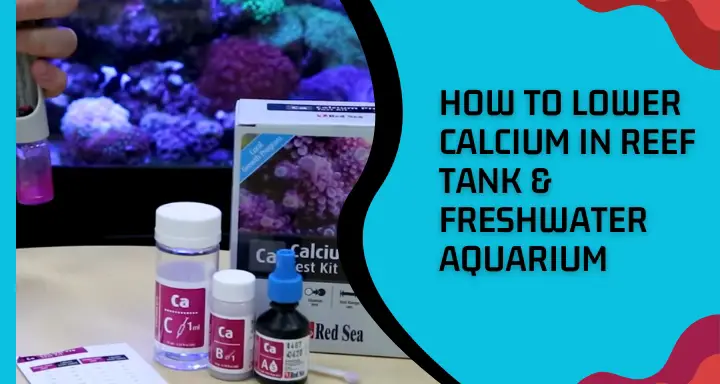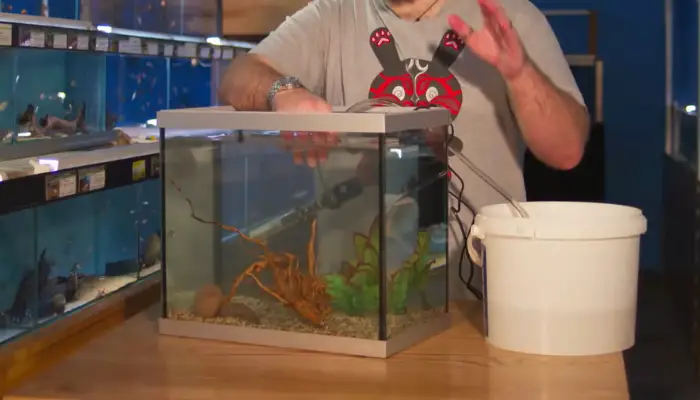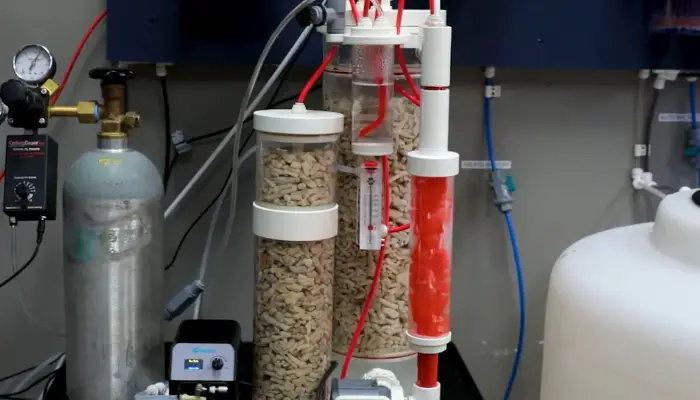
Ways of reducing calcium is a mandatory need for most hobbyists. I used to ask all of the people in my surroundings how to lower calcium in my reef tank. You won’t believe how many ideas I gathered from them. But unfortunately, most of them were not so effective for me.
I became disappointed and then met a specialist who suggested me 4 methods of reducing calcium. They were supposed to be miracles for my reef tank. At first, I used to apply them singly. But, the next year, I made a combo of two or three ways, and yeah! It worked excellently.
Thus, I gathered my experience about this term and now I want to suggest to you also so that you need not take hassles like my previous experience. Let’s jump into it.
4 Easy Ways to Reduce Calcium in Reef Tank
Water Changes

This thought is commonly established that regular water changing procedures can help to reduce calcium levels. It is done by diluting the concentration of calcium in the tank. But the common factor gets complicated when a hobbyist start to do that.
The water changing of such a big tank is not an easy task. It is recommended to perform a 10-20% water change every 1-2 weeks to maintain healthy water parameters.
But how to do that? Look at my techniques first, you have to know the current calcium level of your reef tank to determine how much calcium you need to remove. You can use a test kit to measure the calcium level accurately.
Once you know the calcium level, you can calculate how much water to change to reduce it to a safe level. You can use an online calculator or ask a professional to help you with this calculation and complete that.
At the same time, you need to prepare the new water for the water change. Use a high-quality salt mix and reverse osmosis (RO) water to make sure that the new water has the right level of calcium and other essential elements.
After taking the preparation, you can perform the water change. You can use a siphon or a pump to remove the old water and replace it with the new one. But, you should examine the calcium level regularly to make sure that it stays within the safe range.
Using Calcium Reactor

A calcium reactor is a device that can be used to maintain consistent calcium levels in a reef tank. Look at how to lower calcium by using a calcium reactor.
To complete the procedure, install the calcium reactor in your reef tank system, following the manufacturer’s instructions. Then, add calcium reactor media (usually crushed coral or aragonite) to the reactor chamber. The media will dissolve and release calcium ions into the water as it reacts with carbon dioxide in the reactor.
After that, adjust the pH of the reactor water to around 6.5 to 6.8 using a carbon dioxide regulator. This will create an acidic environment that allows the media to dissolve properly and release the calcium ions into the water.
Finally, monitor the calcium levels regularly in your reef tank using a calcium test kit. Adjust the pH and CO2 levels as needed to maintain a stable calcium concentration.
It is to be noted that regular cleaning of the reactor and replacing the media as needed to ensure it continues to function properly.
Use a Calcium Absorbing Media
Next, I can give you one more idea and that is using a calcium-absorbing media. Trust me you will love this. Here, you have to use calcium-absorbing media such as calcium reactor media, aragonite, or dolomite. These media work by binding with excess calcium ions in the water.
It can then be removed through regular water changes or with the help of a protein skimmer. In this case, choose the appropriate media for your tank size and calcium level. It is recommended to start with a small amount and gradually increase as needed.
Then, place the media in a filter bag or media reactor and install it in your tank’s filtration system. Don’t forget to monitor the calcium level frequently using a reliable test kit to ensure that it is within the optimal range for your reef inhabitants.
As the media absorbs calcium, it may also release other elements into the water, so it’s important to maintain proper alkalinity and magnesium levels as well. But you should be concerned to replace the media periodically as recommended by the manufacturer to ensure that it remains effective.
Adjusting Light
You can apply this as an additional medium. But light adjustment alone will not be effective to control high calcium and alkalinity in reef tanks. Light can indirectly affect calcium levels by promoting the growth of corals that consume calcium
In general, high-intensity lighting can promote the growth of calcium-consuming corals and other invertebrates. It will lead to a decrease in calcium levels. Therefore, if you are experiencing high calcium levels in your reef tank, you may want to consider reducing the intensity of your lighting or the duration of your lighting period.
What Happens If Calcium is Too High in a Reef Tank
The question that I commonly face is why I need to remove the excessive calcium in my reef tank. I have mentioned those problems that I used to face due to excessive calcium in my reef tank. If you want, you can check them and match if you also facing these or not.
The first problem that I noticed is the alkalinity imbalance. High levels of calcium can lead to an imbalance in alkalinity in reef tanks. A perfect alkaline situation is essential for the growth and health of corals. An alkalinity imbalance can cause coral growth to slow down or stop altogether.
Also, precipitation can be found on the underside of the tank. When calcium levels are too high, calcium carbonate can precipitate out of the water. This material can form unsightly white deposits on aquarium surfaces. This can make it difficult to maintain a clean and healthy environment for the reef.
Excessive calcium deposition can drastically reduce fish. High calcium levels can also affect the pH of the water, making it more alkaline. This can be harmful to fish and other animals in the aquarium, as well as the corals themselves.
Moreover, excessive calcium levels can also impact the levels of other elements in the water, such as magnesium and potassium. This can lead to imbalances that can be harmful to the overall health of the reef. Thus, a high calcium level will create disturbance in your whole reef tank.
What Causes High Calcium in Reef Tanks
Now, you may have questions about how the calcium level is increased in a reef tank. Let me suggest to you some reasons that I experienced in my reef tank.
Overdosing of Calcium Supplements
The first reason that I will mention here is overdosing on calcium supplements. Calcium supplements such as calcium chloride or calcium carbonate are commonly used in reef tanks to maintain the calcium level. Overdosing these supplements can lead to an excessive buildup of calcium in the tank.
High Alkalinity Levels
The next reason may be high alkalinity levels. High levels of alkalinity can cause calcium to precipitate out of the water. Such precipitation may lead to a buildup of calcium in the tank. Thus, one compound can increase to another compound.
Excessive Calcification
Also, excessive calcification can increase the amount of calcium. Fish and other organisms in the reef tank require calcium to build their skeletons and shells. If there is excessive calcification happening in the tank, it can lead to high levels of calcium.
Low Magnesium Levels
Here, I will show you a relationship between calcium and magnesium in a reef tank. Magnesium is important in regulating the availability of calcium in the water. Low magnesium levels can lead to an excessive buildup of calcium. Thus, magnesium increases calcium.
Poor Water Circulation
The reason that made me suffer the most is the poor water circulation. Poor water circulation can lead to localized areas of high calcium concentrations in the tank. As far as I experienced from my tank and others, calcium levels may increase in these ways in a reef tank.
How to Lower Calcium in Freshwater Aquarium
Besides reef tanks, you may need information about how to lower calcium in freshwater aquariums. Sometimes, this knowledge may also help you to get rid of too much calcium in your reef tank.
Perform Regular Water Changes
One of the easiest ways to lower calcium levels in your aquarium is by performing regular water changes. Replace a portion of the water in your tank with fresh water. Then, you can dilute the calcium concentration and keep it at a healthy level.
Use a Reverse Osmosis (RO) System
Also, an RO system can help to remove excess minerals and contaminants from your tap water before it enters the aquarium. This can help reduce the overall calcium levels in your tank.
Adjust Your Fish Food
Some fish foods, particularly those that contain a lot of calcium, can increase calcium levels in the aquarium. You can reduce the amount of calcium in your fish’s diet by selecting a food with lower calcium content or reducing the frequency of feeding.
Use Chemical Filtration
Additionally, you can use chemical filtration to help remove excess calcium from the water. Activated carbon and phosphate-removing media can help reduce calcium levels in your aquarium.
Monitor Your Water Parameters
Regularly testing your aquarium water can help you to keep track of calcium levels and take action if they become too high. This can help prevent issues like excessive algae growth and hard water deposits.
How to Test Calcium in a Reef Tank
As you know, testing calcium levels in a reef tank is an important part of maintaining the health and well-being of the tank’s inhabitants. Maybe you have applied several methods meanwhile. Still, I want to mention some so that you can explore new ideas.
Firstly, one of the easiest ways to test calcium levels in a reef tank is by using a calcium test kit. These kits typically use a colorimetric test that measures the number of calcium ions in the water. Follow the instructions provided with the kit carefully to ensure accurate results.
Also, digital calcium testers are available that use a probe to measure the calcium level. These testers may provide more accurate readings than other methods but it is considered an expensive method.
Else, some aquarium controllers, have built-in calcium monitoring capabilities. These controllers can provide real-time readings of calcium levels and can be programmed to send alerts if levels fall outside of a certain range.
Regardless of which method you choose, it is important to test calcium levels regularly to ensure that they remain within the appropriate range for the types of corals and other creatures in your reef tank.
What is the Ideal Calcium Level
Meanwhile, I have discussed a lot of facts regarding calcium measurement in a reef tank. But I think a detailed chart about the ideal calcium level in different water tanks and aquariums can give you proper planning in maintaining calcium levels in your aquarium.
| Water tank | Optimum Calcium |
| Reef tank | 380-450 ppm (parts per million) |
| Saltwater aquarium | 380-450 parts per million (ppm) |
| Freshwater aquarium | 100-200 ppm (parts per million) |
| Brackish aquarium | 300-400 ppm (parts per million) |
| Planted aquarium | 20-30 ppm (parts per million) |
| Nano aquarium | 380-450 ppm (parts per million) |
| Coldwater aquarium | 300-450 ppm (parts per million) |
Will High Calcium Kill Corals?
Yes, high levels of calcium can be harmful to corals if they are not properly balanced with other important water parameters. This time, you may ask me if calcium is an important component of coral skeleton formation. Then why am I indicating it as harmful?
Well, let me explain. Calcium is important for corals, but too much calcium can cause precipitation of calcium carbonate on the coral surface. Such Precipitation can inhibit coral growth and respiration.
Additionally, high levels of calcium can also lead to the depletion of other important elements such as magnesium and carbonate. Also, it may reduce alkaline levels. These elements are essential for coral health.
That’s why to maintain healthy coral growth, it is important to keep calcium levels within the recommended range for your particular coral species. It is also important to maintain appropriate levels of other water parameters such as alkalinity, magnesium, and pH which all work together to create a healthy environment for corals.
Is Too Low Calcium Also Harmful?
Yeah! Too low calcium levels can be harmful to a reef tank. When calcium levels are low, it can slow down the growth of aquatic organisms. Low calcium levels can make them weaker and more susceptible to disease and predation.
Additionally, if calcium levels are not maintained at the appropriate level, corals may not be able to uptake other important elements such as magnesium and strontium. The absence of these materials can further harm the health of the reef.
That’s why you should regularly test and maintain calcium levels in a reef tank to ensure the health and growth of the organisms within it. Neither high nor low calcium is perfect for the plant.
FAQs
How often should I perform water changes to reduce calcium levels?
The frequency of water changes depends on the size of your tank and the level of calcium you are trying to achieve. In general, it is recommended to perform regular water changes of 10-20% of your tank volume every 2-4 weeks.
Are there any risks to reducing calcium levels in my reef tank?
Reducing calcium levels too quickly or drastically can cause stress to your tank’s inhabitants, particularly corals. It is important to make changes slowly and monitor your tank’s parameters closely to avoid any adverse effects.
How quickly can calcium levels be reduced?
The rate at which calcium levels can be reduced will depend on the method used and the starting calcium levels. For example, performing a partial water change may result in an immediate reduction, while using a calcium reactor may take several days or even weeks to see a significant impact.
Final Words
However, if anyone asks me, “How do you lower the calcium level in your reef tank?”, I answer them easily in this way. But, a point is here to be noted. But you have to apply the chemical method carefully. Also, the cleansing procedure should be perfect and well applied.
Thus, you can maintain the ideal calcium level properly in your reef tank. If you want to ask anything about other topics, feel free to ask me. I will try to share my experiences about that. Most importantly, good maintenance of the tank environment can make you relieved from any type of problem.
- Top 15 Freshwater Aquarium Plant Ideas for a Lush, Green Tank - November 9, 2024
- Top 13 Freshwater Aquarium Layout Ideas for a Beautifully Organized Tank - November 9, 2024
- 14 Stunning Rustic Freshwater Aquarium Ideas for a Tranquil Environment - November 9, 2024
